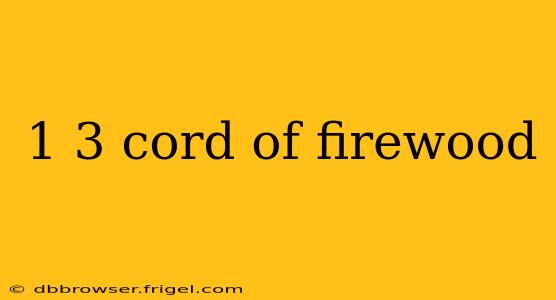Buying firewood can feel overwhelming. Understanding cord measurements is crucial to ensuring you get the right amount for your needs. This guide delves into the specifics of 1 1/3 cords of firewood, exploring its volume, uses, and considerations for purchase.
What is a Cord of Firewood?
Before we dive into 1 1/3 cords, let's clarify what a cord is. A standard cord of firewood measures 4 feet high, 4 feet wide, and 8 feet long. This equals 128 cubic feet of stacked wood. It's important to note that this is a stacked measurement, meaning the wood is neatly arranged, not loosely piled. The air gaps between pieces are included in the calculation.
How Much is 1 1/3 Cords of Firewood?
1 1/3 cords is exactly what it sounds like: one full cord plus one-third of a cord. Therefore, it's equal to 170.67 cubic feet of neatly stacked wood (128 cubic feet + 42.67 cubic feet). This is a significant amount of firewood, likely sufficient to heat a medium-sized home for a considerable portion of the winter, depending on factors such as the type of wood, your home's insulation, and your heating habits.
How Much Space Does 1 1/3 Cords Take Up?
The space occupied by 1 1/3 cords depends on how it's stored. If neatly stacked as a single unit, it would occupy a space roughly 4 feet high, 4 feet wide, and 10.67 feet long. However, you'll likely store it differently, possibly in a woodshed or stacked against a wall. Consider the available storage space before purchasing such a quantity.
How Many Pieces of Firewood are in 1 1/3 Cords?
The number of individual pieces in 1 1/3 cords varies considerably depending on the size of the pieces. Smaller pieces will result in a higher number of pieces within the same volume. There's no single definitive answer; it's highly dependent on the woodcutter's practices.
Is 1 1/3 Cords Enough for My Winter?
Determining if 1 1/3 cords is sufficient for your winter heating needs requires considering several factors:
- Home Size and Insulation: Larger, poorly insulated homes will consume more firewood.
- Type of Wood: Different woods have varying BTU (British Thermal Units) ratings. Hardwoods like oak burn longer and hotter than softwoods like pine.
- Climate: Colder climates naturally require more firewood.
- Heating Habits: How often do you use your wood stove or fireplace?
It's best to consult with local firewood suppliers or experienced wood burners to estimate your needs based on your specific circumstances.
What are the benefits of buying in bulk (like 1 1/3 cords)?
Buying in bulk, such as 1 1/3 cords, often comes with cost savings per unit. Furthermore, it reduces the frequency of deliveries and ensures you have a consistent supply throughout the winter, avoiding potential supply shortages or price increases.
What should I consider before buying 1 1/3 cords of firewood?
- Storage: Ensure you have adequate, dry storage space to protect the wood from the elements.
- Seasoning: Make sure the wood is properly seasoned (dried) to ensure efficient burning and minimal creosote buildup. Green (unseasoned) wood produces less heat and more smoke.
- Delivery: Confirm delivery options and costs with the supplier, especially if you need the firewood delivered to a location not easily accessible.
- Type of Wood: Research different wood types and their burning characteristics to choose the best option for your needs and budget.
This comprehensive guide provides a solid understanding of 1 1/3 cords of firewood. Remember to always factor in your individual circumstances to determine if this quantity suits your needs. Consult local experts for personalized advice to ensure a warm and cozy winter.
